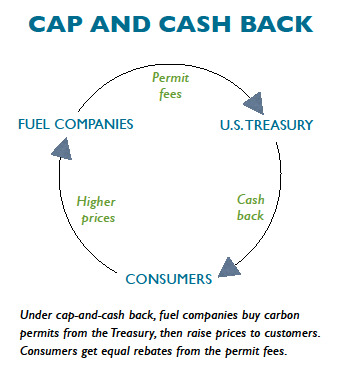The Senate is tied in knots on climate legislation. In President Obama’s view, putting an economy-wide price on carbon is the most effective way to stimulate clean energy investment and jobs. Most Democrats — though not enough — agree. Roughly half a dozen Republicans, given some political cover, might go along, but the party’s leadership opposes a “national energy tax.” Sixty filibuster-proof votes are therefore not in sight. And after November, when Democrats are expected to lose seats, the prospects look even grimmer. What is to be done?
The conventional wisdom is to court Senatorial votes by giving handouts and exemptions to polluting industries. This has been the strategy pursued by Sens. John Kerry (D-Mass.), Joseph Lieberman (I-Conn.), and “pragmatic” greens until now. It hasn’t worked and isn’t likely to. The complexities are too great, and throwing people’s money at giant energy companies isn’t a popular idea these days.

There is, however, another way forward. It starts with the cap-and-cash-back approach, a.k.a. cap-and-dividend, embodied in the bipartisan CLEAR Act co-sponsored by Sens. Maria Cantwell (D-Wash.) and Susan Collins (R-Maine). Their 39-page bill caps and prices all carbon emissions, but instead of rewarding polluters — most of whom will pass their cost of polluting to their customers — it protects the people who will ultimately pay the bills — namely, us.
The CLEAR Act requires all first sellers of carbon — fuel companies like Exxon-Mobil and Peabody Coal — to buy permits from the federal government. These permits are auctioned, not given away free (after all, polluters should pay), and three-quarters of the proceeds are returned as equal payments to all legal U.S. residents. This is accomplished electronically every month, like Social Security. U.S. manufacturers and workers are protected by carbon fees at the border.
This straightforward system has numerous virtues. First, it’s simple, market-based, and explainable. Second, it would spur conservation, efficiency, and innovation throughout the economy, while keeping government out of the dicey and costly business of picking winners. Third, it’s transparent — it’s easy to see how the money flows.
Perhaps cap-and-cash-back’s greatest virtue is the pocketbook protection it affords middle class families throughout the long transition to clean energy. As carbon prices climb, so automatically will the cash families get back. Those with big houses, cars, and travel budgets will pay more in higher prices than they’ll get back (as they should), but roughly 70 percent will get back more than they pay. In other words, rather than imposing a national tax, cap-and-cash-back puts money in most Americans’ pockets.
Despite its self-evident appeal, political insiders have dismissed the CLEAR Act because it doesn’t buy off special interests, presumably a sine qua non in Washington these days. Another criticism is that it shifts money from people in the Midwest, where utilities rely mostly on coal, to people in other states whose electricity is less carbon-intensive. The magnitude of this shift is actually quite small, and it can be entirely eliminated — as Cantwell has suggested — by giving all states as much money back as they pay in.
The interesting political question is what to do with the 25 percent of auction revenue that isn’t returned to the people. The sums involved aren’t chicken feed: they’d amount to hundreds of billions of dollars over 40 years. The present version of the bill puts that money in a trust fund dedicated to an assortment of climate-friendly purposes. But other uses of this revenue might give the bill more traction while preserving its core virtue — installing a rising price on carbon in a simple, transparent and popular, hence durable, way.
What if, for example, that 25 percent was allocated to two grand public purposes: grants to states for job creation and federal deficit reduction? The proportions could change over time, with more job creation in the early years and more deficit reduction down the road. Such a clean-energy-plus-jobs-plus-deficit-reduction package might entice fence-sitters on both sides of the aisle. And because it’s short and simple, it could be offered as an amendment to another bill that comes to the floor this year.
Pulling this off would require, of course, presidential leadership; Obama would have to push the plan to senators and explain it forcefully to the American people. The latter task, fortunately, plays to his strength. And even in today’s acrimonious political climate, it would be hard for voters — and, one presumes, their senators — to resist a bipartisan policy that creates jobs, reduces our financial and ecological debts, and pays hard cash to everyone.



